Why do so many strategies fail to get implemented effectively?
Robin Speculand from Bridges Business Consultancy has found that only one out of three transformations in today’s digital world delivers on their promises. Defined that they achieve at least 50% of strategic objectives, and only one and eight companies go on to deliver a long-term sustained differentiation. There are a number of factors that can contribute to that launch failure, but one that is rarely considered is whether there has been adequate preparation before starting the strategic planning process.
When the managing partners of a top-tier law firm in Asia invited us to support their leadership team ahead of a major strategy day, we knew where to start. It might be a surprising angle, but it’s not always best to start with what you think you want to achieve from the strategy itself. We didn’t begin with vision statements or market forecasts. We began by identifying any points of friction. Not dysfunction, but the kind of tension that can become highly productive and that can fuel sustainable innovation and transformational change when properly understood and managed.
Many professional services firms like this face competing demands such as balancing regulatory rigour with client-centric innovation, and managing internal governance while exploring new service models. To navigate this process, we introduced some tools that could help identify gaps and opportunities.
What emerged wasn’t just a simple snapshot of the challenges: it was the first step in designing a strategic blueprint. It revealed where collaboration could thrive, and where misalignment might quietly derail execution.The Pre-Strategy session didn’t replace their strategy day, it supercharged it. By aligning leadership styles, surfacing paradoxes, and building strategic muscle memory, the team was ready to lead with clarity and confidence.
Before Strategy: Why Smart Teams Start with Alignment Rather than Risking Jumping Straight In
In the rush to set bold goals and map out quarterly priorities, many leadership teams overlook a critical phase: the moment before strategy begins.
A Pre-Strategy Workshop should be more than just a warm-up or a team-building exercise. It should be a strategic intervention designed to surface tensions, align perspectives, and build the shared language needed to lead with clarity and cohesion. Especially in regulated, high-stakes environments, skipping this step can mean the difference between a strategy that sticks—and one that stalls.
Even the most experienced teams carry invisible fault lines: competing priorities, divergent leadership styles, and unspoken assumptions about what “success” looks like. When these aren’t surfaced early, they show up later—as misalignment, friction, or strategic drift.
Initial signals that these tensions might need to be addressed might be: “We’re moving fast but losing clarity”, “We’re stuck between wanting to innovate and needing to maintain current systems and structures”, or “We’re aligned in purpose but not energized”.
- Leadership teams that talk about collaboration but operate in silos
- Strategy sessions that feel productive but lack follow-through
- Innovation initiatives that stall due to control-based resistance
What Happens in a Pre-Strategy Workshop?
- Leadership diagnostics to reveal how each person approaches innovation and change
- Paradox mapping to identify tensions that must be navigated—not resolved
- Collaborative canvassing to build strategic pathways through complexity
- Scenario alignment to test assumptions and stress-test priorities before formal planning begins
- Visualize competing priorities without oversimplifying
- Strategically position themselves for both agility and stability
- Build a shared language for innovation and execution
Why It Matters
RECOMMENDED PRE-STRATEGY, STRATEGIC PLANNING & WORKSHOP TOOLS
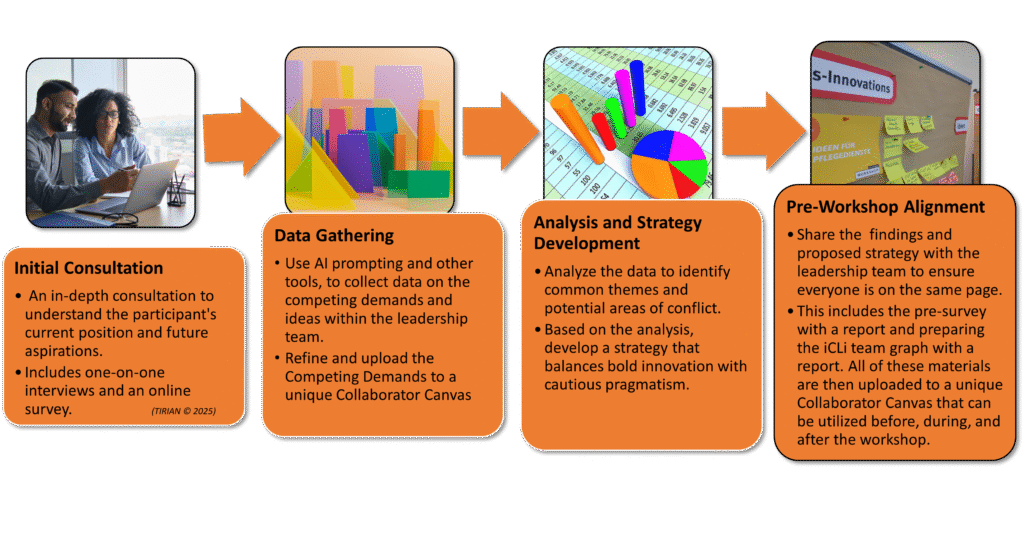
We recommend it’s best to start by conducting a proactive pre-workshop to achieve pre-strategy alignment. This involves working closely with the client beforehand and drawing from a comprehensive toolkit to identify and understand their diverse demands. One of the key components we include in our toolkit is a specialized AI prompting guide, which helps to capture the nuanced needs and aspirations of the leaders. In a Pre-Strategy Workshop, we then also draw from the suite of Tirian tools (see below) designed for leadership teams operating in complex, regulated, or innovation-critical environments.
Our recommended Pre-Strategy Workshop planning process:
Initial Consultation: We begin with an in-depth consultation to understand the participant’s current position and future aspirations. (includes one-on-one interviews and online survey).
Data Gathering: Using AI prompting and other tools, we collect data on the competing demands and ideas within the leadership team.
Analysis and Strategy Development: We analyze this data to identify common themes and potential areas of conflict. Based on this analysis, we develop a strategy that balances bold innovation with cautious pragmatism.
Pre-Workshop Alignment: Before the workshop, we share our findings and proposed strategy with the leadership team to ensure everyone is on the same page. This includes the pre-survey with a report and preparing the iCLi team graph with a report. All of these materials are then uploaded to a unique Collaborator Canvas that can be utilized before, during, and after the workshop.
This proactive approach not only prepares the participants for the workshop but also sets the stage for the successful implementation of the strategy. By aligning the leadership team beforehand, we ensure that the workshop is productive and focused on moving forward together.
The Strategic Planning Toolkit:
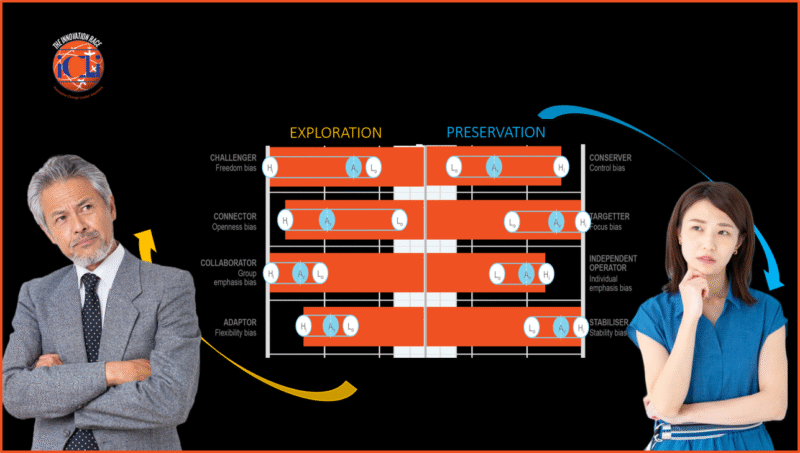
TOOL #1: iCLi Profiling Tool
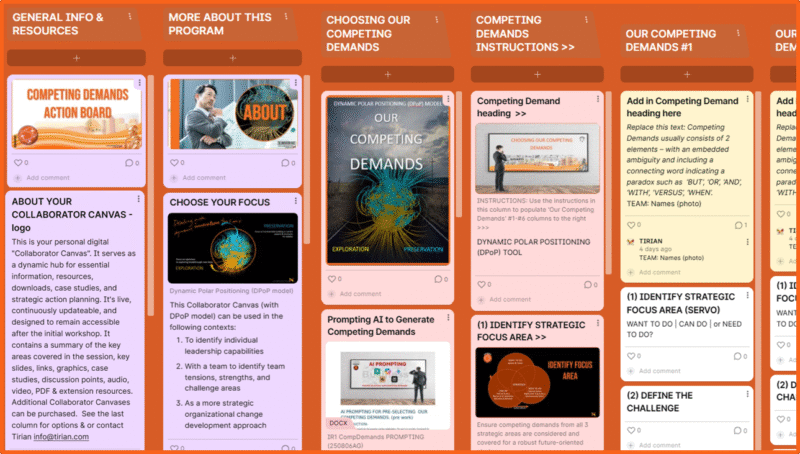
TOOL #2: Competing Demands Collaborator Canvas
- Clarity on strategic tensions
- Shared language for paradox navigation
- Actionable innovation pathways
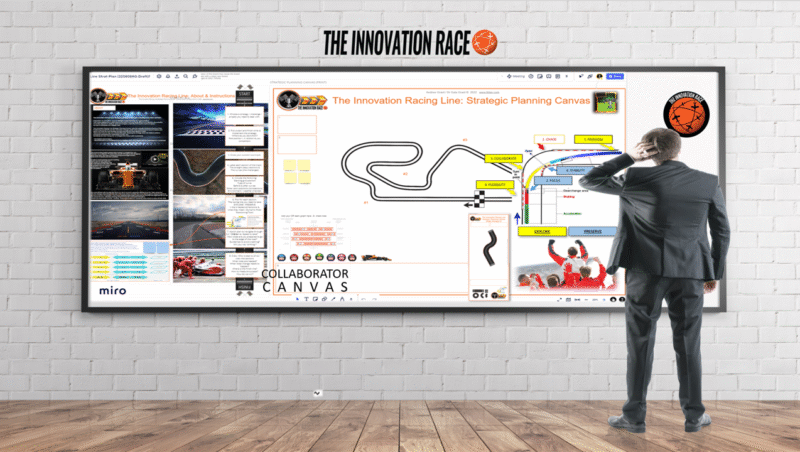
TOOL #3: Innovation Racing Line Collaborator Canvas
“The Pre-Strategy session for our partners didn’t replace our strategy day—it supercharged it. By aligning leadership styles, surfacing paradoxes, and building strategic muscle memory, the team was ready to lead with clarity and confidence.”
Yuli Soepadio | HHP Law Firm, (Indonesia) member firm of Baker McKenzie International
Reference. https://www.bridgesconsultancy.com/wp-content/uploads/2016/10/20-Years-of-Strategy-Implementation-Research-2.pdf


